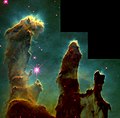This article needs to be updated.(May 2020) |
This article includes a list of references, related reading, or external links, but its sources remain unclear because it lacks inline citations .(May 2020) |
The Hubble Heritage Project was founded in 1998 by Keith Noll, Howard Bond, Forrest Hamilton, Anne Kinney, and Zoltan Levay at the Space Telescope Science Institute. [1] Until its end in 2016, [1] the Hubble Heritage Project released, on an almost monthly basis, pictures of celestial objects like planets, stars, galaxies and galaxy clusters.

